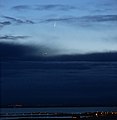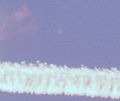Comet McNaught: Difference between revisions
rv vandalism |
|||
| Line 25: | Line 25: | ||
Soon after confirmation of the discovery, Southern Hemisphere observers began following the comet to refine the orbit. From August through November 2006, the comet was imaged and tracked with [[Charge-coupled device|CCD]] cameras, giving an [[apparent magnitude|estimated brightness]] as high as 12. For most of December, the comet was lost in the glare of the [[Sun]].<ref>{{cite web|url=http://cometography.com/lcomets/2006p1.html|title=Kronk's Cometography - C/2006P1|accessdate=2007-01-17}}</ref> |
Soon after confirmation of the discovery, Southern Hemisphere observers began following the comet to refine the orbit. From August through November 2006, the comet was imaged and tracked with [[Charge-coupled device|CCD]] cameras, giving an [[apparent magnitude|estimated brightness]] as high as 12. For most of December, the comet was lost in the glare of the [[Sun]].<ref>{{cite web|url=http://cometography.com/lcomets/2006p1.html|title=Kronk's Cometography - C/2006P1|accessdate=2007-01-17}}</ref> |
||
Upon recovery in late December, it became apparent that the comet was brightening rapidly. It became visible to the naked eye in early January 2007. It was visible in the northern hemisphere near [[Venus]], [[Aquila (constellation)|Aquila]], and [[Ophiuchus]], until about [[13 January]] [[2007]]. [[Perihelion]] (closest approach to the sun) was [[12 January]] [[2007]] at a distance of 0.17 [[Astronomical_unit|AU]].<ref name ="recentest">[http://cfa-www.harvard.edu/icq/CometMags.html#2006P1 Recent Comet Brightness Estimates]</ref> Due to its proximity to the sun it had a short window for viewing, and could only be spotted during twilight. |
|||
[[Image:Mcnaught_orbit.png|thumb|left|The [[orbit]] (green) of Comet McNaught on [[14 January]] [[2007]] and the four orbits (orange) of the inner planets. [[Earth]] is the blue dot on the right. The [[Milky Way]] can be seen on the lower left.]] |
|||
The comet entered [[Solar and Heliospheric Observatory|SOHO]] LASCO C3's [[field of view]] [[12 January]] [[2007]], and quickly became brighter than [[C/2002 V1|Comet NEAT]] in 2003. The comet exited SOHO's field of view on [[16 January]] [[2007]]. |
The comet entered [[Solar and Heliospheric Observatory|SOHO]] LASCO C3's [[field of view]] [[12 January]] [[2007]], and quickly became brighter than [[C/2002 V1|Comet NEAT]] in 2003. The comet exited SOHO's field of view on [[16 January]] [[2007]]. |
||
Revision as of 20:54, 21 January 2007
This article documents a current event. Information may change rapidly as the event progresses, and initial news reports may be unreliable. The latest updates to this article may not reflect the most current information. |
| Comet C/2006 P1 over New Zealand | |
| Discovery | |
|---|---|
| Discovered by | Robert H. McNaught |
| Discovery date | 7 August, 2006 |
| Designations | |
| C/2006 P1, Comet McNaught, 2006 P1 | |
| Orbital characteristics | |
| Epoch | 2454113.2961 (20 January, 2007) |
| Perihelion | 0.1707420 AU |
| Semi-major axis | -5681.10388683203 AU |
| Last perihelion | 12 January, 2007 |
| Next perihelion | N/A |
C/2006 P1, also known as Comet McNaught, is a non-periodic comet discovered on August 7 2006 by Robert H. McNaught.[1] It made perihelion on January 12 2007, and became easily visible to the naked eye for observers in the Southern Hemisphere.
History
Soon after confirmation of the discovery, Southern Hemisphere observers began following the comet to refine the orbit. From August through November 2006, the comet was imaged and tracked with CCD cameras, giving an estimated brightness as high as 12. For most of December, the comet was lost in the glare of the Sun.[2]
Upon recovery in late December, it became apparent that the comet was brightening rapidly. It became visible to the naked eye in early January 2007. It was visible in the northern hemisphere near Venus, Aquila, and Ophiuchus, until about 13 January 2007. Perihelion (closest approach to the sun) was 12 January 2007 at a distance of 0.17 AU.[3] Due to its proximity to the sun it had a short window for viewing, and could only be spotted during twilight.

The comet entered SOHO LASCO C3's field of view 12 January 2007, and quickly became brighter than Comet NEAT in 2003. The comet exited SOHO's field of view on 16 January 2007.
On 12 January, McNaught became the brightest comet in more than 40 years,[4] being the brightest comet seen since Comet Ikeya-Seki in 1965. The comet has been dubbed the Great Comet of 2007.[5] On January 13 and 14, 2007, the comet attained an estimated maximum apparent magnitude of -6.0 in the Northern Hemisphere.[6] Perigee (closest approach to the Earth) was 15 January 2007, at a distance of 0.82 AU.[7]
According to reports on spaceweather.com, the comet was visible in daylight about 5°- 10° southeast of the sun from January 12 to 14, with a peak brightness of magnitude -5.5.
After passing the sun, Comet McNaught became visible in the Southern Hemisphere. In Australia, according to Siding Spring Observatory at Coonabarabran, where the comet was discovered, the comet was to have reached its theoretical peak in brightness on Sunday, 14 January 2007 just after sunset,[8] when it would have been visible for 23 minutes after sunset. On 15 January 2007 the comet was observed at Perth Observatory with an estimated apparent magnitude of -4.0.[3]
Current viewing
The comet remains visible to Southern hemisphere observers in both the morning and evening sky, entering the constellation Microscopium on 18 January, forecast to fade rapidly and drop below 6th magnitude by 9 February. However, observers are encouraged to watch closely, as sungrazing comets often break up shortly after perihelion and flare dramatically. As of 20 January the comet is clearly visible to southern observers in the Western sky after sunset, near to the horizon, about a hand-span left of Venus (the hand-span measured at arm's length). The comet is so bright that its tail can be easily seen in twilight from city locations in the southern hemisphere. It can even be seen from very dark locations in the Northern hemisphere that are near the equator.
Image gallery - January 2007
- Images of Comet McNaught
-
over Iceland
-
Near the Inner Coastal Range of Central California, 12 January
-
In broad daylight on 13 January
-
Above the Sydney skyline on 16 January
-
Seen from South Beach, Fremantle, Western Australia on 17 January. The lights at the bottom are navigation lights in Gage Roads.
-
In Philippolis, South Africa on 17 January, about 8 P.M.
-
From Signal Hill, Cape Town on 19 January. On the left is the silhouette of Lion's Head, and on the right the evening star, Venus.
-
From the Sugarloaf Mountain, in Rio de Janeiro, on 19 January. The comet is on the left, above the clouds. Also visible is Venus, and Rio's skylight, including the statue of Christ the Redeemer.
-
Nucleus of comet McNaught as seen from Cape Town, South Africa.
-
As seen from Llandudno, Cape Town on 20 January. The moon and Venus are low above the horizon on the right of the picture
-
Quinns Beach, Butler, Western Australia, 20 January
-
Over the Olympic Mountains in Washington.
References and footnotes
- ^ "Report on the comet discovery and progress from Robert McNaught's homepage". Retrieved 2007-01-17.
- ^ "Kronk's Cometography - C/2006P1". Retrieved 2007-01-17.
- ^ a b Recent Comet Brightness Estimates Cite error: The named reference "recentest" was defined multiple times with different content (see the help page).
- ^ "Brightest comets seen since 1935". Harvard. Retrieved 2007-01-12.
- ^ The Great Comet of 2007: Watch it on the Web Yahoo News, January by Joe Rao of SPACE.com Skywatching Columnist. Accessed 16 January 2007
- ^ Recent Comet Brightness Estimates
- ^ "Southern Comets Homepage". Retrieved 2007-01-17.
- ^ Siding Spring Survey
External links
- McNaught, Robert (2007). "C/2006 P1 (McNaught's own page)". Siding Springs Observatory. Australian National University. Retrieved 2007-01-21.
{{cite web}}: Cite has empty unknown parameter:|coauthors=(help) - Comet orbital elements and diagram, from a NASA website
- 9 January 2007 NASA-hosted Astronomy Picture of the Day, featuring the comet
- Current hotshots of comet, from NASA's Solar and Heliospheric Observatory website
- animation of comet as it enters and exits LASCO C3's FOV
- Comet McNaught photo gallery from Southern Hemisphere




















